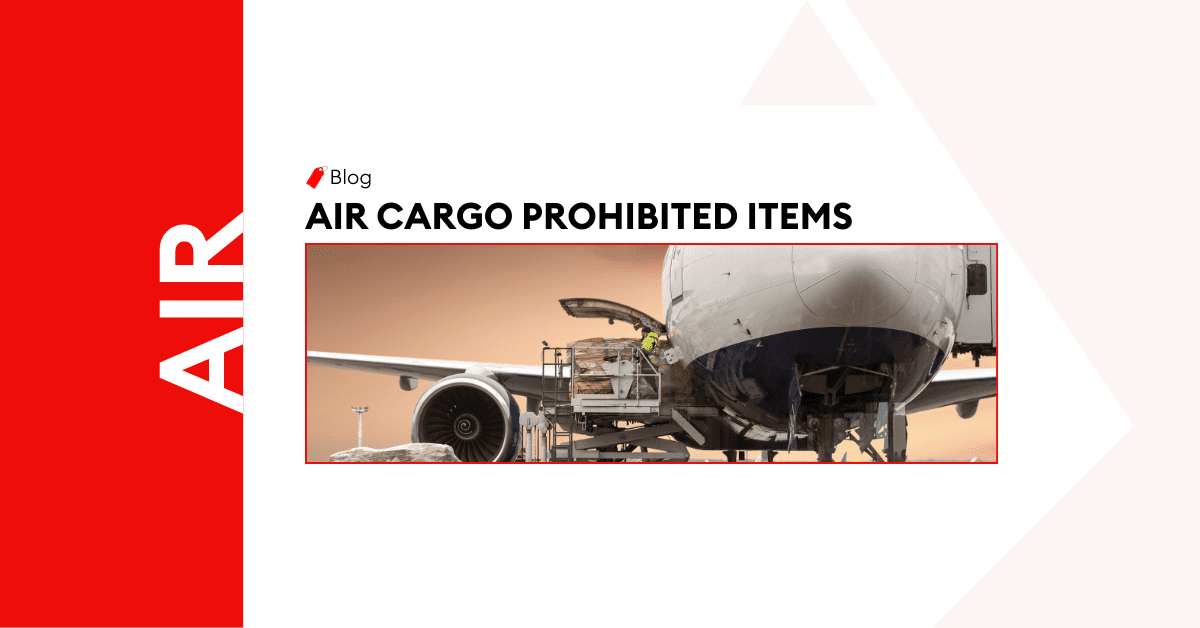
A Guide to Air Cargo Prohibited Items

Are you carrying with you something not allowed for carry-on baggage in your air shipment?
Well, you should be aware of this, there is a list of items that will not allow entry into most of the countries in the world. There are many reasons behind it. It could be religious, economic, political, harmful to human health, and so forth.
This article will discuss the prohibited and restricted goods, rules and regulations, Dos, and Don’ts, airlines and their prohibited items list, and what are the dangerous goods.
No doubt, it’s plenty of benefits when you move your goods via air. It’s faster, reliable, more secure, and has less transit time. Air cargo has some rules and restrictions that you need to know more about prohibited and restricted articles when you choose air shipment.
What is the Major Difference Between Prohibited and Restricted items?
Prohibited Goods:
Some common items that are prohibited which you may consider to be harmful to human health and which may be shipped using proper approval from the relevant Authority or Airline on which it may be flying.
Restricted Goods:
These certain items can’t be imported as personal effects into many countries or may be subject to inspection and/or treatment or obtaining an import license.
Prohibited Articles / Load for Air Cargo:
With additional restrictions, some restricted items are endangered for the aircraft or passengers’ safety and health.
- Explosives and fireworks
- Gases and fire extinguisher
- Flammable liquid or solid
- Pesticides and Lithium batteries
- Strong magnetic products
- Radioactive material and Lab chemical
What are Restricted and Prohibited Goods?

We are giving you the list of articles that are prohibited by laws and by regulations.
Items Prohibited for Air Transportation By-Laws
Article 1 | Deadly poison infectious materials of all kinds |
Article 2 | Narcotics and psychotropic drugs of all kinds |
Article 3 | Arms, imitation arms/ammunition, detonators, and explosives of all kinds; |
Article 4 | Newspapers, magazines/pictures, promotional materials/audio, and video products |
Items prohibited for air transportation by regulations
Article 5 | Explosives, such as fireworks and firecrackers, detonating fuses, etc. |
Article 6 | Gases, such as compressed gas, dry ice, fire extinguisher, gas cartridge |
Article 7 | Flammable liquid, including paint, gasoline, alcohol, engine oil, camphor oil |
Article 8 | Flammable solid, pyrophoric substances, and substances that emit flammable gases |
Article 9 | Toxic and infectious items, such as pesticides, lithium batteries, etc. |
Article 10 | Corrosive items, such as batteries, alkaline battery electrolytes, etc. |
Article 11 | Magnetic substance, magnet without degaussing packaging, magnetic steel |
Article 12 | Items that go against public health, such as corpses and bones |
Article 13 | Oxidizers, organic peroxides, radioactive materials, and corrosive items, such as chemical medicines, lab chemicals |
Article 14 | Powder (regardless of color), liquid (regardless of package), paste |
Article 15 | Biochemical products and infectious materials of all kinds, such as bacillus anthracis |
List of the Top Airlines With Their Prohibited items
What are Dangerous Goods?
Certain articles and objects that can be harmful to human health and as well as for the environment are called dangerous goods or hazardous material.
It includes Flammable substances, Gasoline/ oil, Batteries, Explosives, pesticide, lab chemicals, radioactive substances, etc.
They are further classified into 9 categories with many sub-divisions.
- Class 1: Explosives
- Class 2: Gases
- Class 3: Flammable liquid
- Class 4: Flammable solids
- Class 5: Oxidizing Substance
- Class 6: Toxic and infectious substance
- Class 7: Radioactive
- Class 8: Corrosives
- Class 9: Other substance and articles
Do’s and Don’ts for Air Cargo
First of all, you need to find out if your goods don’t violate any rules or regulations. Many freight forwarders follow different sets of rules when it comes to air shipment restrictions.
There are some standard guidelines that you need to follow to keep your products free from any harm. Along these lines, it will not be harmed during the delivery cycle.
Do’s
- Do check the measurements to see whether it’s correct or not according to the type of shipment and storage space.
- Staff members and plane crew must be aware of all the safety procedures when it comes to shipping dangerous goods or substances.
- Do make sure all boxes or cartons should be correctly labeled according to the type of goods like HEAVY or FRAGILE.
- Remove the old labels in case of using an old box or carton so the carrier won’t be confused
- Do make two printed copies of the label, one for inside the box and another one should be tapped outside the box.
- Do check the nature of the carton/box before pressing. It ought to be sufficiently able to not be broken during the transportation cycle.
- Put the cushion or thermocol inside the wall so your goods will be safe and secure.
Don’ts
- Don’t use strips or rope for packing, try to use strong packing tape instead.
- Don’t overburden the box. Try to wrap each item individually
- Don’t label wrong information regarding the package. Provide correct details about the goods.
Conclusion
When you decide to move your cargo by airline. They must inform you about the regulatory frameworks. But it would be the most ideal choice when you enlist an accomplished cargo forwarder. Who can guide you correctly and set a high value on reliable and clear contracting terms with no extra cost?
Related Articles
A Guide to Air Cargo Prohibited Items
Are you carrying with you something not allowed for carry-on baggage in your air shipment? Well, you
Seamless & Secure Art Transport from Dubai to Doha | A Case Study
Reliable, Secure, and Efficient Art Transport Summary Al Sharqi successfully executed an airfreight
Moving Temperature-Controlled Perishable Products from London to Abu Dhabi | A Case Study
Reliable, Fast, and Secure Transport Summary A leading food supplier needed a seamless airfreight so






Post a comment
You must be logged in to post a comment.